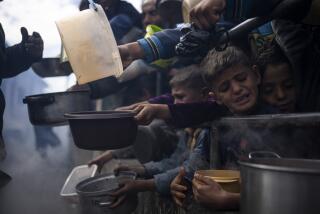MILITARY : Heavy Duty in Somalia: Feeding Hungry Troops : The range of U.S.-provided goods and services for the multinational force seems endless.
- Share via
MOGADISHU, Somalia — A few days ago, the U.S. Army began buying bananas and grapefruit from Somalis to feed the troops participating in Operation Restore Hope.
Almost everything else, bottled mineral water included, is being imported.
As the United States looks forward to the time when most of its service personnel here will be sent home and replaced with other countries’ forces under U.N. command, supply will become a growing part of the U.S. military’s contribution to helping Somalia.
From GI rations to dental care, diesel fuel and reliable laundry service, the list of U.S.-furnished goods and services for a multinational force that now tops 38,000 seems endless.
And, American military officials say, the United States is picking up most of the tab.
“We’re basically feeding everybody,” explains Col. Bob Tanner, deputy commander and chief of staff of the Army’s Joint Task Force Support Command, which took over from the U.S. Marine Corps this week the daunting job of supplying Operation Restore Hope.
Tanner says his job is like that of an American city manager--except that his four “mini-cities,” each designed to house and service 10,000 military personnel, are in the process of being built and are situated in one of the world’s most isolated countries to boot.
What does it take to equip the coalition now in Somalia so that U.N. agencies, private charities and foreign governments can work in peace to end famine here? In a foghorn voice that betrays his Rhode Island roots, Tanner, 43, runs down a long list.
Enough wells must be drilled and water purified and stored to supply 20 gallons a day per person. A fleet of 90 5,000-gallon tanker trucks just for water distribution has already arrived and is lugging water up to 300 miles inland.
Off Somalia is anchored a U.S. barge that can desalinate up to 250,000 gallons of water a day, although Tanner acknowledges that Americans prefer to drink mineral water out of clear plastic bottles, the sort brought in from the United Arab Emirates.
A total of 6,000 military vehicles must be kept gassed up and ready to go, from Humvees to heavy-duty construction equipment like road graders and bulldozers.
Engineers are building and mending so many roads that, if laid end to end, they would stretch from New York to Denver.
Showers, latrines, laundries, sit-down mess halls and “hardback” tents with wooden sides must be erected in the mini-cities being built for foreign forces. Air terminals must be able to handle a range of aircraft from the Army’s Huey helicopters to C-5A transport planes.
Mogadishu was without power when the U.S. forces landed last month; now, the Army and Marine Corps are able to provide full electric power to the mini-cities, as well as the big wattage needed to run a satellite communications network.
The scope of the U.S. financial commitment to Operation Restore Hope is shown by the food. Each MRE ration (meals, ready to eat) costs taxpayers between $7 and $8, Tanner says. And the United States is now supplying virtually all service personnel in Somalia with food, he added, meaning more than 100,000 meals daily.
In exchange, Tanner said, some members of the coalition provide goods or services--the Canadians have important airlift capability, for instance. The Australians pay for what they eat.
The tab run up by each country is tallied and passed to the Army’s 4th Material Management Center, Tanner said. But it will ultimately be up to the U.S. government to decide which IOUs to attempt to collect.
“Right now, we’re paying the bill,” said Tanner, who lives at Ft. Hood, Tex., and whose computer-equipped Mogadishu office is located in the remnants of the national university.
Pilferage, he admits, has fast become the “greatest security problem.” Impoverished Somalis have crawled through triple strands of concertina wire to steal almost anything of value, and the arrival of a huge cache of supplies in this desperate country is a powerful temptation.
The Army quartermaster, a lean man with steel-framed glasses, does not hide his satisfaction over the use being made of U.S. military might and of his own talents in Somalia. For 40 years, he says, the United States honed its ability to project its power throughout the world for military and security reasons.
“Now, we’re here policing up thugs and hoodlums, people who are out of control,” he said. “It’s more Christian.”
Supply Network
To supply the U.S.-led 22-nation force now in Somalia, here is what is now in place: * Diesel fuel stockpiles of 3.2 million gallons in Mogadishu.
* Engineers, vehicles and materials to repair and reconstruct 2,000 miles of roads and bridges. * Electrical-generating capacity to power four towns. * 15 Blackhawk helicopters serving as air ambulances; 20 Humvee ambulances, 28 doctors and 815 other medical personnel. * A “bag farm” of collapsible tanks resembling huge waterbeds on Mogadishu’s beach that hold 2.1 million gallons of water. * Food to provide three meals a day for 38,000 soldiers, sailors and airmen. Source: Army’s Joint Task Force Support Command
More to Read
Sign up for Essential California
The most important California stories and recommendations in your inbox every morning.
You may occasionally receive promotional content from the Los Angeles Times.










